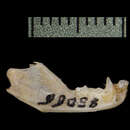en
names in breadcrumbs


While in the wild, this species of vampire bat may live about 9 years. In captivity they may survive much longer ("Vampire Bats" 2001).
Perception Channels: tactile ; chemical
Hairy-legged vampire bats are the rarest of the three vampire bat species (McCarthy 1987).
US Federal List: no special status
CITES: no special status
IUCN Red List of Threatened Species: least concern
Because hairy-legged vampire bats almost always feed by taking the blood of birds, they rarely attack humans. If they were to bite a human, the wounds would not be serious. However, it is possible for them to transmit rabies and other diseases through those wounds. Because hairy-legged vampire bats may occasionally take blood from livestock and trasmit diseases, they are potentially economically important to cattlemen and sportsmen of Texas as a reservoir of bovine paralytic rabies (Texas Parks & Wildlife 1994; Carattini 2001; Britannica 1999-2000).
Diphylla ecaudata produces an anticoagulant in their saliva that is about 20 times more powerful than any other anticoagulant known. The saliva has been used as a blood-thinning drug to treat heart attacks and strokes in humans ("Vampire Bats" 2001).
Hairy-legged vampire bats feed on the blood of warm-blooded vertebrates, mostly birds, including domestic chickens. Through the use of heat sensors on their nose, these vampire bats can seek an area of the prey's skin where there is a good amount of blood close to the surface. They lick the skin to soften the bite area and to rid it of hair or feathers. They then bite a small, V-shaped wound which is about 2.5 mm deep. Usually the victim is not aware of the bite. It has been observed that these bats attack the legs and cloacal region of chickens and then suck up the blood while in an upright position. When feeding on birds roosting in trees, these bats grip a branch with their hind feet and thumbs. They then situate themselves underneath a bird and make an incision. Terrestrial locomotion has not been reported in this species of vampire bat. An anticoagulant in the saliva allows blood to flow freely from the wound.
The feeding process usually takes about a half an hour. An adult may consume about 5 teaspoons of blood, which is about half of its body weight. After the bat feeds, it urinates continuously until it is light enough to fly again. The longest this bat can go without eating is 2 nights. If Diphylla ecaudata does not eat for more than 2 nights in a row then it will die from starvation. It has been estimated that about 1/3 of hairy-legged vampire bats does not eat each night, they must then rely on shared food from roost mates (Schutt & Altenbach 1997; Tomlinson; Texas Parks & Wildlife 1994).
Diphylla ecaudata can be found from southern Texas to eastern Peru and southern Brazil (Carattini 2001; Texas Parks & Wildlife 1994).
Biogeographic Regions: nearctic (Native ); neotropical (Native )
Diphylla ecaudata is primarily an inhabitant of tropical and subtropical forestlands. They can be found in both mesic, forested and arid, open areas. During the daytime these bats roost in caves, mine tunnels, hollow trees, or abandoned buildings ("Vampire Bats" 2001; Texas Parks & Wildlife 1994).
Terrestrial Biomes: savanna or grassland ; forest ; rainforest ; scrub forest
Diphylla ecaudata, commonly referred to as hairy-legged vampire bats, range from reddish brown to sooty brown in color. They have a narrow, hairy interfemoral membrane and a pug-nosed snout. Hairy-legged vampire bats are distinguished by their typically smaller body and ears than other vampire bats. They also have a total of 26 teeth, more than other vampire bat species. Hairy-legged vampire bats have highly modified upper incisors. These incisors are larger than the canines and occlude against each other so that they are continuously sharpened to a very fine edge. The outer incisors are much reduced (Carattini 2001; Texas Parks and Wildlife 1994).
Range mass: 30 to 40 g.
Other Physical Features: endothermic ; bilateral symmetry
Diphylla ecaudata is sexually mature at 9 months and reproductively active throughout the year. Common months of pregnancy for females have been reported to be in March, July, August, October, and November. Gestation is 6 to 8 months. The number of embryos per female is normally one and they may produce a single offspring one or two times a year (Texas Parks & Wildlife 1994).
Key Reproductive Features: gonochoric/gonochoristic/dioecious (sexes separate); sexual